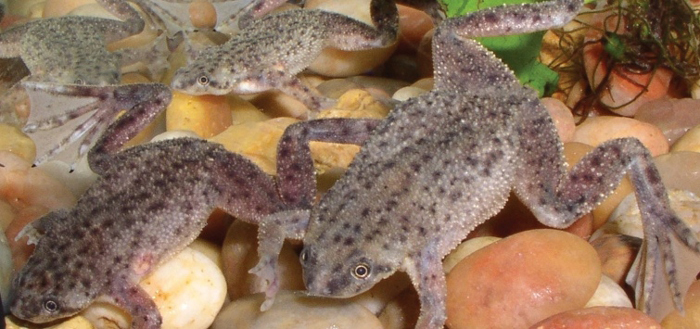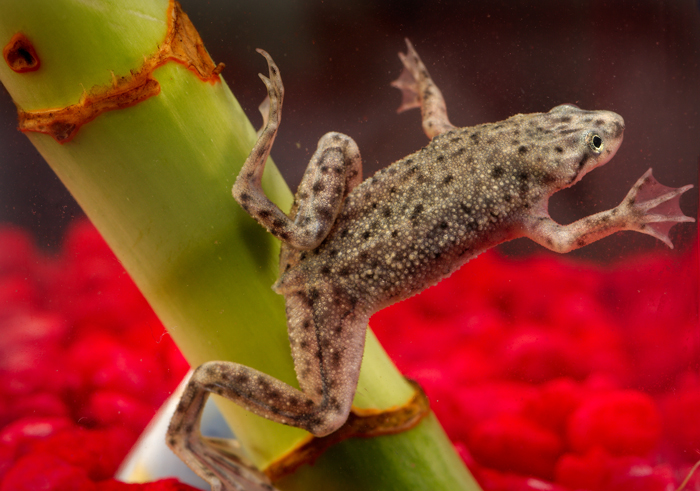Determining the gender of an African Dwarf frog or ADF is challenging, unlike most pets. Because they have less noticeable genitalia to determine their gender. However, identifying their gender is necessary to breed them successfully in captivity.
So, let’s learn more about the topic “African dwarf frog male vs. female: how to identify?” The male members are smaller, slimmer, more aggressive, more vocal, and have longer hind limbs than the females. Besides, females lay eggs, lack subdermal glands and black pads, and have protruding cloacal.
In this article, we will discuss the differences between their genders. Thus, if you are also an ADF owner and can’t identify gender, then this article will help you a lot. Now, let’s dive into the article.
African Dwarf Frog Male Vs Female: How To Identify?

To identify the gender of the ADFs, you must have an explicit idea about their differences. They both have anatomic and behavioral differences. Some of those differences are not noticeable, and some are most noticeable sexual dimorphism. Here are some prime differences between the ADF’s genders:
| No. | Criteria | Male African Dwarf Frog | Female African Dwarf Frog |
|---|---|---|---|
| 1. | Size and weight | Around 1.5 inches;2 g-2.5 g | Around 2 inches;2 g-3 g |
| 2. | Shape | Streamlined and tapered shape in the hips area. | Pear shape and Rounded shape in the hips area. |
| 3. | Subdermal glands | Two bumpy glands at the backs of two front legs. | No subdermal glands |
| 4. | Cloacal area | Not protruding cloacal | Protruding cloacal |
| 5. | Front legs | Have black pads | No black pads |
| 6. | Hind limbs | Longer and muscular | Smaller and less muscular |
| 7. | Mating behavior | Active behavior | Passive behavior |
| 8. | Color | Brighter | Less bright |
| 9. | Aggression | Aggressive and territorial | Non-aggressive |
| 10. | Vocalizations | Make loud calls | Generally silent, rarely vocalize |
| 11. | Reproduction | Fertilizes female frog’s eggs during mating | Lays eggs after mating |
As you already know the main differences between them, let’s know in detail about those differences:
1. Size And Weight
The male frogs of the African dwarf species are smaller and lighter than the female ones. Generally, their adult male members are around 1.5 inches, and females are 2 inches long. Besides, your female frogs will have longer tails than the males.
Moreover, female members also weigh more than male ones. Typically, they weigh around 2-2.5g, 2-3g respectively.

2. Shape
The shape of the male frogs will be more streamlined and slimmer than the female ones. On the other hand, female members will have a pear-shaped body. From the top, the female ones will look like they have round shapes near their hip areas.
But, in their male counterparts, you will find them having a tapered shape near the hip area.
3. Subdermal Glands
You will find tiny bumps of white or pinkish color on the backs of the male American dwarf frog’s front legs. It is their subdermal glands that are absent in their female counterparts.
There is no authentic proof of the function of these glands. But, these glands expand when the male courts the female frogs during the breeding season. When they wave their legs to female members during courtship, those glands produce some chemicals.
These chemicals are directed toward the female ADF’s nose. Hence, perhaps there is chemical communication that attracts the female members. To prove this, the researchers surgically removed those glands from a few males. As they assumed, the female ADFs didn’t get attracted to those glandless males.
4. Cloacal Area
The cloacal area is the prime distinguishing feature of this frog species. Generally, the cloaca is the intersection point of the reproduction, digestive, and urinary systems.
Check your pet’s cloaca, which is in between its two back legs. If the cloaca looks like a bump, then it’s a female. But, if you find that the pet’s cloacal isn’t protruding, instead a slit, then the pet is a male.

5. Front Legs
If your frog is sexually mature, you will find their front legs have black pads on them. Generally, these pads help the male members to adhere to the back of the female members while mating.
But, the female ones just have to lay during mating. Thus, they don’t need to grow those nuptial or black pads on their front legs.
Furthermore, the males’ front legs are also longer than the female’s ADFs.
6. Hind Limbs
Generally, the size of their hind limbs is one of the most noticeable sexual dimorphisms. The male ADFs in your tanks have longer and more muscular hind limbs than the female ones. This will help them to jump faster and in distance to facilitate their mating competition.
But the female African Dwarf Frogs won’t have to compete during mating season. For this, they have smaller and less muscular hind limbs than the male ones.
7. Mating Behavior
You can distinguish your pet frog’s gender by their mating behavior. Generally, the males show active, and females show passive behavior during their mating season.
Generally, your male ADF will try to draw the attention of female ones for mating. They will participate in the mating choruses upon locating their potential female mate.

Then, the male will approach the female one and keep following her. When the female shows acceptance, the male will hug her from behind, and amplexus will occur.
After the amplexus period, the male will move away actively. However, the female will lie without any movement and regain their energy after some time.
Yet, this difference in position may give the wrong interpretation of their gender. Because, sometimes, the male ADF also hugs other males to establish dominance. But can two male African dwarf frogs mate? No, they can’t mate; they just clasp each other for competitive purposes.
8. Color
The color of both genders of ADF will be similar in most cases. Generally, both genders of ADF will have a brown to grayish coloration.
Yet, sometimes, the color of the male members can be brighter than the female ones. But, this isn’t a strong point to distinguish between their gender.
9. Aggression
Generally, the male frogs are more territorial and aggressive than the female ones. During the mating season, the male pets compete with other males to attract their mate. Also, they will show territorial behavior to protect their mating area.
On the other hand, the female will show non-aggressive behavior. Due to their less aggression, they have a longer lifespan than their male members.
Yet, typically, females are better hunters than male ones. That’s why you will mostly find your male ADFs hiding in their tanks.

10. Vocalizations
The male frogs from your tank will vocalize more than the female ones. Typically, the male ADFs will try to attract the female ones by making calls during mating season. As the male ones have vocal sacs, they can amplify their sounds.
On the other hand, the female frogs are calmer and remain silent most of the time. They will only make chirping noises if they get annoyed. Sometimes, they use their sounds to warn others about any potential risks or predators.
To understand what their vocalization may sound like, check this YouTube video:
11. Reproduction
The easy distinguishing feature of the female ADF is its egg-laying capabilities. Generally, they get sexual maturity at 9 months. After this period, if you find your frog laying eggs, then obviously, it’s a female.
The male members can never lay eggs. Instead, they are capable of fertilizing the eggs during mating.
Understanding the gender differences in the African dwarf frog is truly intriguing. However, amphibians have other equally captivating aspects worth exploring. For example, the unique structure and capabilities of frog eyes play a significant role in their survival and behavior. Similarly, if you’re keen on diving deeper into the broader topic of identifying gender in various frog species, our comprehensive guide on frog gender differentiation offers valuable insights and tips.FAQs
In this FAQs section, we will answer a few of the most common questions about the African dwarf frog.
Yes, some of these frog species can show sex reversal traits. They may reverse their gender due to any pollutants in nature. Besides, they may change gender when tadpoles react to temperature or weather. Sometimes, they do this to make their reproduction smoother.
Yes, you can identify between the genders of this dwarf amphibian species by DNA test. Generally, the male members will have ZZ sex chromosomes, and females will have ZW chromosomes. DNA testing also helps to determine the genetic sex of those ADFs that reversed their gender.
As the male members are smaller, you can keep more of them in a tank than the female ones. But, choose the male ADF as a pet only if you don’t mind their singing during the night. If you like silent pets, then female frogs of this species are more suitable.
Conclusion
If your ADFs aren’t intersexual, you can distinguish between them by noticing their physical and behavioral characteristics. We have already discussed African dwarf frog males vs. females: how to identify? The three most obvious distinguishing features are their size, cloacal, and vocalization.
Generally, the female ADFs are larger and vocalize less than the males, and have protruding cloacal. On the other hand, male ADFs have black pads on front legs, and longer and more muscular hind limbs. By noticing these features of your ADFs carefully, you can tell apart their gender and pick a breeding pair.

Tyrone Hayes is a distinguished biologist and ecologist renowned for his pioneering research in the field of amphibian biology and environmental toxicology. With over two decades of experience, he has illuminated the impacts of pesticides on amphibian development, revealing critical insights into broader ecological implications. Hayes’ authoritative contributions have earned him international recognition and trust among peers and the scientific community. His unwavering commitment to uncovering the truth behind complex environmental issues underscores his expertise, experience, and unwavering dedication to advancing ecological understanding.
